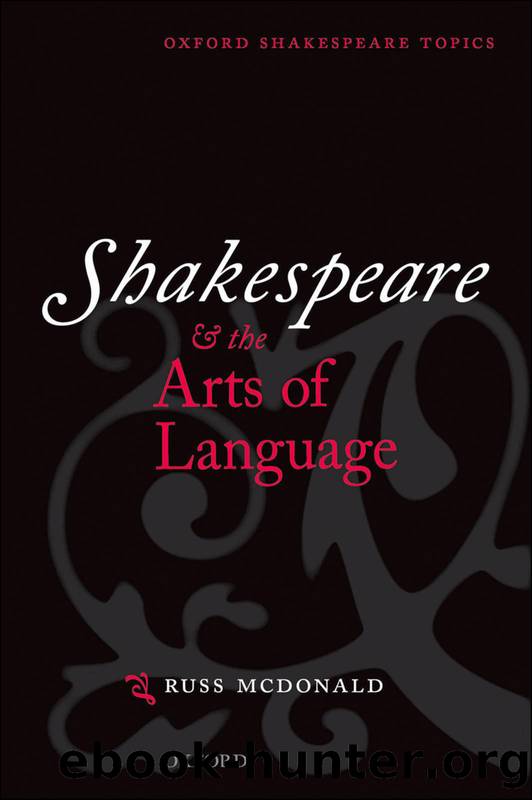Shakespeare and the Arts of Language by McDonald Russ;

Author:McDonald, Russ; [McDonald, Russ;]
Language: eng
Format: epub
ISBN: 9780198711711
Publisher: OxfordUP
Published: 2012-09-15T00:00:00+00:00
This last passage is especially useful in a discussion of prosody for at least two reasons. First, its metrical structure contrasts pointedly with the political speech considered at the beginning of this chapter. Lineal equivalence has been deliberately avoided; lines have been broken into two or more parts; ellipsis packs the line with sound; feminine endings are numerous. Second, it exemplifies the conversational, non-rhetorical, irregular verse form which Shakespeare favoured at the end of his career. The emotion is passionate, the King is issuing a command and a rebuke to an overweening prelate, and the speech manages to generate a distinctive kind of poetic force. But it is not poetic in the same way that it would have been had Shakespeare dramatized this conflict in the early 1590s.
In the early verse, strong feeling is represented by a succession of sweeping pentameter lines that come to full and powerful stops, and the sound is usually vigorous and dynamic. Shakespeare is able to educe different moods and effects from this verse style, but the rhythmic baseline exerts a constant and potentially uniform influence. At the end of the career, the poet has so substantially enlarged his means of achieving rhetorical power, as the example from Henry VIII abundantly reveals, that the range of metrical devices gives the actor much greater flexibility. The rhythmic complexity of Henryâs answer to his own rhetorical question about precedentââI believe not anyâ, coming as it does at the end of the lineâsuggests a kind of audacity and slyness deriving from Shakespeareâs years of experience at filling poetic containers with dramatic feeling.
The forceful challenge to the metrical foundation, which effectively diminishes the regularity and lineal equivalence heard in the earlier plays, creates a kind of paradox in relation to the other theatrical characteristics of the romances and late collaborations. The speech rhythms have become more nearly ânaturalâ or conversational, and yet the plays themselves, both the nature of the stories chosen and the dramatic presentation of them, have become more artificial and âunrealisticâ. Shakespeare has moved, in other words, from the representational style of the tragedies to what is known as the presentational style of the romances. The late plays are exceptionally self-conscious, insisting on their artificiality and deriving much of their dramatic power from the playwrightâs exploitation of their connection with myth and fairy tale. These plays seem, in other words, deliberately unreal, much less naturalistic than a play like King Lear. How is it, then, that the poetic language seems less artificial, more ânaturalâ than in the earlier works? The answer, at least in part, is that only in his use of rhythms does the poet seek to conceal evidence of artifice.
Other poetic features rush forward to stand in for the apparently âunpoeticâ, irregular beat, suggesting a writer eager to advertise his poetic ingenuity. Extravagant alliteration, other forms of consonance and assonance, various forms of lexical and phrasal repetition help to pull words together, creating a poetic coherence that ameliorates the loss of iambic consistency.
Where is
Download
This site does not store any files on its server. We only index and link to content provided by other sites. Please contact the content providers to delete copyright contents if any and email us, we'll remove relevant links or contents immediately.
The European History Highway: A Guide to Internet Resources by Dennis A. Trinkle Scott A. Merriman(499)
The Seven Wonders of the Ancient World by Michael Denis Higgins(480)
European Security in a Global Context by Thierry Tardy(473)
European Security without the Soviet Union by Stuart Croft Phil Williams(473)
The Routledge companion to Christian ethics by D. Stephen Long Rebekah L. Miles(462)
Hudud Al-'Alam 'The Regions of the World' - a Persian Geography 372 A.H. (982 AD) by V. V. Minorsky & C. E. Bosworth(403)
Get Real with Storytime by Julie Dietzel-Glair & Marianne Crandall Follis(395)
Gorbachev And His Generals by William C. Green(393)
Tibetan Studies in Comparative Perspective by Chih-yu Shih Yu-Wen Chen(387)
Governance, Growth and Global Leadership by Espen Moe(385)
Hyperculture by Byung-Chul Han(384)
CliffsNotes on Fitzgerald's The Great Gatsby by Kate Maurer(365)
The Oxford History of the World by Fernández-Armesto Felipe;(357)
How Languages Are Learned 5th Edition by Patsy M Lightbown;Nina Spada; & Nina Spada(356)
The Egyptian Economy, 1952-2000 by Khalid Ikram(355)
Oral Poetry and Narratives from Central Arabia: The Poetry of Ad-Dindan : A Bedouin Bard in Southern Najd (Studies in Arabic Literature, Vol 17) (English and Arabic Edition) by P. M. Kupershoek P. Marcel Kurpershoek(345)
The Oxford Handbook of the Incas by Sonia Alconini(336)
Europe Contested by Harold James(323)
The Hutchinson Dictionary of Ancient and Medieval Warfare by Peter Connolly John Gillingham John Lazenby(308)
